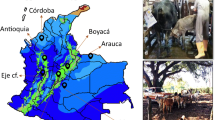Abstract
In most Hungarian dairy farms clinical coccidiosis of calves had been misdiagnosed because of the lack of information on the presence of Eimeria sp. in local animals, causing inestimable animal health problems and economical losses. For this reason the first countrywide study on coccidiosis of calves was carried out in 86 dairy farms. Faecal samples were collected from 743 calves aged between two and four months old in 2005 and 2006. The number of animals enrolled per farm ranged between two and ten. During the qualitative ovoscopy, 100 oocysts per sample were examined for species identification. Eimeria oocysts were found in 245 (33%) samples. Of the seven species identified, the most prominent species were E. auburnensis (19.6%), E. ellipsoidalis (15.9%) and E. bovis (14.9%). Eimeriazuernii, E. cylindrica, E. pellita or E. subsphaerica oocysts were found in less than 20 samples each. Multiple infections with two or more species occurred in 83 (33.9%) calves. The oocysts of at least one of the two pathogenic species, E. bovis and/or E. zurnii, were found on every farm studied, which infected 118 (48.2%) animals, however, clinical coccidiosis was not observed. Coccidia of Eimeria were present in 74 (86.0%) out of 86 farms, occurring countrywide, where the number of Eimeria sp. ranged between one and six. Based on these preliminary results the authors emphasise that veterinarians and cattle owners should be familiar with clinical signs and the potential implications of cattle coccidiosis. Management procedures and application of anti-coccidial compound are needed for minimising the impact of coccidiosis.
Similar content being viewed by others
References
Cornelissen AWCA, Verstegen R, van den Brand H, Perie NM, Eysker M, Lam TJGM, Pijpers A (1995). An observational study of Eimeria species in housed cattle on Dutch dairy farms. Vet Parasitol 56:7–16.
Daugschies A, Akimura M, Burger HJ (1986). Experimental Eimeria bovis infections in the calf: 1. Parasitological and clinical findings. Dtsch Tierärztl Wochenschr 93:393–397.
Daugschies A, Burger HJ, Akimaru M (1997). Effects of experimental infection with Eimeria bovis on the balance of sodium, potassium and water in calves. Parasitol Int 46:159–169.
Daugschies A, Najdrowski M (2005). Eimeriosis in cattle: current understanding. J Vet Med B 52:417–427.
Eckert J, Braun R, Shirley MW, Coudert P (eds) (1995). Guidelines on techniques in coccidiosis research. COST 89/820 Biotechnology pp. 104–106.
Ernst JV, Ciordia H, Stuedemann JA (1984). Coccidia in cows and calves on pasture in North Georgia (USA). Vet Parasitol 15:213–221.
Ernst JV, Benz GW (1986). Intestinal coccidiosis in cattle. Vet Clin N Am Food Anim Pract 2:283–291.
Faber JE, Kollmann D, Heise A, Bauer C, Failing K, Bürger HJ, Zahner H (2002). Eimeria infections in cows in the periparturient phase and their calves: oocyst excretion and levels of specific serum and colostrum antibodies. Vet Parasitol 104:1–17.
Fiege N, Klatte D, Kollmann D, ZahnerH, Bürger HJ (1992). Eimeria bovis in cattle: colostral transfer of antibodies and immune response to experimental infections. Parasitol Res 78:S32–S38.
Fitzgerald PR (1975). The significance of bovine coccidiosis as a disease in the United States. Bovine Pract 11:28–33.
Fitzgerald PR (1980). The economic impact of coccidiosis in domestic animals. Adv Vet Sci Comp Med 24:121–143.
Fox JE (1985). Coccidiosis in cattle. Mod Vet Pract 66:113–116.
Fridrichovszky L, Pellérdy L (1948). Curative treatment of red dysentery of cattle with neotodorit. Magy Állatorv 71:303–304 (in Hungarian).
Gräfner G, Graubmann HD, Kron A, Müller H, Daetz HH, Plötner J, Benda A (1982). Zum Auftreten der Weidekokzidiose in Jungrinderbeständen. Monatsh Veterinaermed 37:776–779.
Hiepe T, Romeyke D, Jungmann R (1978). Untersuchungen über Kokzidien-Infektionen des Kalbes unter Bedingungen der industriemäßigen Rinderproduktion mit einem Beitrag zur Bekämpfung Mh Vet-Med 33:904–910.
Kasim AA, Al-Shawa YR (1985). Prevalence of Eimeria in faeces of cattle in Saudi Arabia. Vet Parasitol 7:95–99.
Kennedy MJ, Kralka RA (1987). A survey of Eimeria spp. in cattle in central Alberta. Can Vet J 28:124–125.
Levine ND (1985). Veterinary Protozoology. Iowa State University Press, Ames, IA.
Lucas AS, Swecker WS, Scaglia G, Lindsay DS, Zajac AM (2006). Variation in Eimeria composition in weanling beef heifers. J Parasitol 92:1115–1117.
Marshall RN, Catchpole J, Green JA, Webster KA (1998). Bovine coccidiosis in calves following turnout. Vet Rec 143:366–367.
Matjila PT, Penzhorn BL (2002). Occurrence and diversity of bovine coccidia at three localities in South Africa. Vet Parasitol 104:93–102.
Mielke, D, Rudnick J, Hiepe T (1993). Untersuchungen zur Immunprophylaxe bei der Kokzidiose des Rindes. Mh Vet-Med 48:425–429.
Mundt HC, Bangoura B, Rinke M, Rosenbruch M, Daugschies A (2005). Pathology and treatment of Eimeria zuernii coccidiosis in calves: Investigations in an infection model. Parasitol Int 54:223–230.
Munyua WK, Ngotho JW (1990). Prevalence of Eimeria species in cattle in Kenya. Vet Parasitol 35:163–168.
Oda K, Nishida Y (1989). Prevalence and distribution of bovine coccidia in Japan. Jpn J Vet Sci 52:71–77.
Parker RJ, Jones GW (1987). The development of Eimerian infections during the first eight months of life in unweaned beef calves in a dry tropical region of Australia. Vet Parasitol 25:1–7.
Pellérdy L (1965). Coccidia and coccidiosis. Akadémiai Kiadó, Budapest.
Step DL, Streeter RN, Kirkpatrick JG (2002). Bovine coccidiosis – a review. Bovine Pract 36:126–135.
Svensson C, Uggla A, Pehrson B (1994). Eimeria alabamensis infection as a cause of diarrhoea in calves at pasture. Vet Parasitol 53:33–43.
Thomas HS (1994). Coccidiosis in calves. The Cattleman 81:21–32.
Zimmerman WJ,Hubbard ED (1961). Gastrointestinal parasitism in Iowa cattle. J Am Vet Med Assoc 139:555–559.
Zsigmondy L (1948). A contribution to the therapy of red dysentery in cattle. Magy Állatorv 71:354–355 (in Hungarian).
Author information
Authors and Affiliations
Corresponding author
Rights and permissions
About this article
Cite this article
Farkas, R., Szeidemann, Z. & Majoros, G. Studies on Coccidiosis of Calves in Hungarian Dairy Farms. Parasitol Res 101 (Suppl 1), 113–120 (2007). https://doi.org/10.1007/s00436-007-0618-4
Published:
Issue Date:
DOI: https://doi.org/10.1007/s00436-007-0618-4




